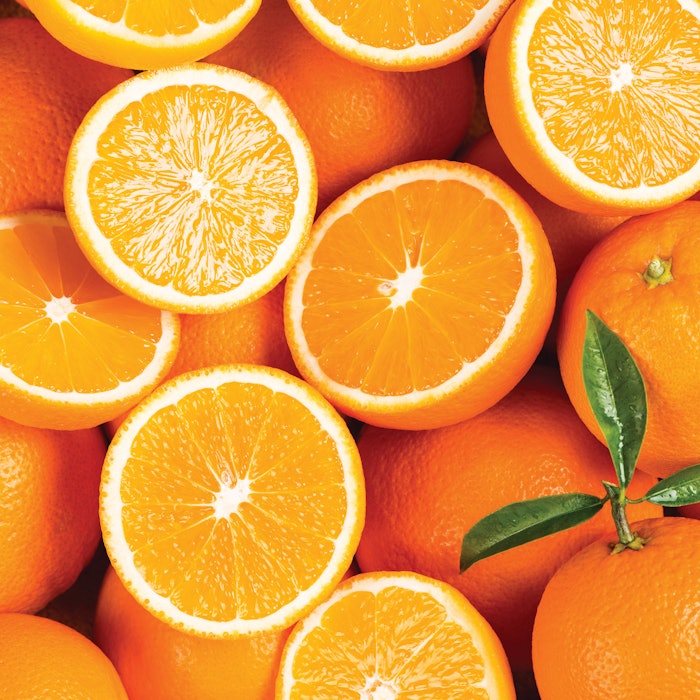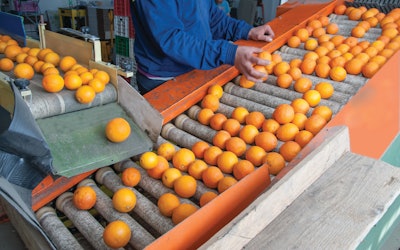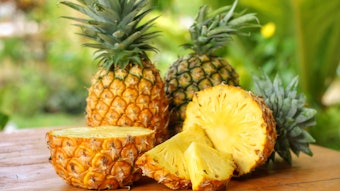
The health of the citrus market is vital for the flavor and fragrance industry. The orange market has been faced with a variety of challenges ranging from extreme climate conditions to competition for land use.
Below is a brief highlight from Peter Greenhalgh, Ph.D.’s Socio-Economic Report Orange published by the International Federation of Essential Oils and Aroma Trades (IFEAT).
Production Characteristics
Global orange production for 2022/23 is expected to be 5% lower at 47.8MMT compared to the last crop owing to lower production in the European Union (EU), the United States, and Turkey, offset partly by a larger crop in Egypt. Fruits allocated to processing will be reduced, resulting in less orange oil production.
The actual amount of processing will be dependent on the value the processor can derive from the juice and orange oil produced. Brazil dominates orange processing but the dramatic fall in recent United States orange production means that for the first time in history, Mexico is the second largest orange processor, followed by the United States and the European Union.
The volume of orange oil, terpenes, and d-limonene produced is directly related to the quantity of oranges processed for orange juice. In 2022/23 orange juice production was estimated to be 9% lower at 1.5 MMT (65 degrees Brix) - equivalent to almost 2 MMT of oranges.
Juice production fell because of the reduced fruit available for processing in the four major producing regions, namely Brazil, Mexico, the EU, and the United States. This in turn reduced the amount of orange by-products produced.
 All growers face major issues with changing climatic conditions and natural variability.
All growers face major issues with changing climatic conditions and natural variability.
Major Production Challenges
There are several major challenges facing orange production and the industry:
• Climatic variations including frosts, droughts, heavy rains, and hurricanes have all seriously impacted production. These climatic factors reduce the fruit size and yields and hence the availability of fruit for processing and essential oil production.
• Disease and pesticides—oranges are susceptible to a range of diseases usually borne by insects that can substantially lower output. Greening is having a major impact on the three major producers Brazil, Mexico, and the United States.
• Agricultural residue issues arising from pesticide residues. The industry faces unclear regulation on pesticides residues and there is a need to coordinate accepted reference values to avoid market distortion.
• Competition for land use—in Florida the population and urbanization have increased, intensifying competition from the real estate sector. In Brazil, land use competition comes from alternative crops particularly sugar cane, used for making biofuel. Moreover, sugar cane can provide a return within a year, whereas oranges not only have a gestation period of 3-4 years but also have added risks of greening and greater price volatility.
Future Production Trends
It is important to recognize that over the past century, there have been sizeable shifts in orange oil production arising from economic, climatic, and other environmental factors which will continue to lead to shifts in the location of production. All growers face major issues with changing climatic conditions and natural variability while some major growers and processors, particularly in the United States and Europe, face substantial pressure on land availability, combined with high labor and other costs.
In contrast in China, Egypt, and Turkey, the industry is reported to be growing and thriving but their dominant focus is growing fresh fruit. The supply of orange by-products depends, to a large extent, on the size of the orange harvest and the volume of fruit available for processing in countries where a processing industry is established.
 Citrus greening is having a major impact on the three major producers Brazil, Mexico, and the United States.
Citrus greening is having a major impact on the three major producers Brazil, Mexico, and the United States.
Conclusions
The most lucrative part of the orange market is the sale of fresh oranges rather than orange juice or by-products generated from processing oranges. The market for orange by-products including orange oil and d-limonene is both a global and a volatile one with price levels similar throughout the world. Prices have increased significantly in the last few years. The combination of citrus greening, climatic factors, labor availability, competitive land usage, limited natural substitutes, rising production costs, lower aldehyde levels often below 1.1%, rising demand, and reduced stock levels all signal a paradigm shift in the market.
Orange production and processing, including the production of orange oil/d-limonene and terpenes, make vital economic, social, and environmental contributions to the orange-producing regions in producing countries, particularly São Paulo (Brazil), Mexico, until recently Florida (USA), Sicily and Catania (Italy) and Valencia and Andalucía (Spain). The industry provides livelihoods for hundreds of thousands of people as well as generating millions of U.S. dollars in sales and export revenues. In addition, the sector makes substantial environmental contributions, and initiatives are being adopted to combat climate change by capturing CO2 as well as providing other environmental benefits.
Full Socio-Economic Report
For the entire Socio-Economic Report on Orange by Greenhalgh, visit https://bit.ly/3FG37Y2.
The full report discusses the growth characteristics, varieties, and range of orange products; the processing, uses and varieties; global trends in production and in major producing countries; major challenges, price trends, economic, social, and environmental aspects.
To see this feature in print, visit Perfumer & Flavorist+ December 2023 issue.










